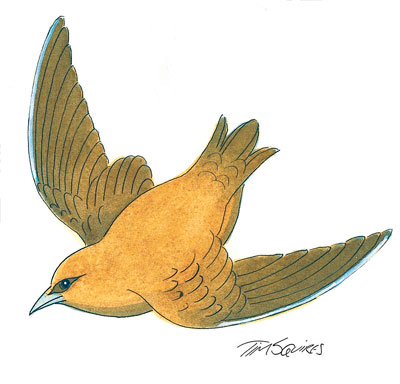 The dusky woodswallows were active and twitchy, soaring into the sky to snatch at the last of the summer’s flying insects. In the upper bare branches of a dead gum they were joined by tree martins.
The dusky woodswallows were active and twitchy, soaring into the sky to snatch at the last of the summer’s flying insects. In the upper bare branches of a dead gum they were joined by tree martins.
The two species jockeyed for position, the martins coming off worst. When a woodswallow returned from a sortie, the smaller martins had to make way for it.
Perhaps it was just me, but I sensed the two species were looking north as autumn got seriously underway, they certainly seemed to head that way after taking off, then swung around and returned to the perch in the foothills below Mt Wellington.
It had been a glorious Indian summer well into March when chill winds and a closing of the days usually tell us that winter is on the way.
A heatwave had lingered, the insects had not been killed and the flying insect-eaters were making hay while the sun shone. Who could blame then for lingering a while, putting off the arduous and dangerous journey north, the crossing of Bass Strait and the journey across Victoria and further to the north?
I checked the wind direction, a breeze from the south-west, and all looked favourable for the migration but the woodswallows and martins – unrelated species although they look similar and display the same hunting behaviour – did not seem to be paying attention.
The danger for migratory birds at this time of year is that a cold snap can change circumstances of migration, killing off the summer insects and leaving the migrants stranded without food.
The high-flying hunters were not alone in their apparent reluctance to leave, to enjoy the last of the summer. Many grey fantails and silvereyes were still about. Before setting out one sunny morning I had read an article in BirdLife Australia magazine describing in magical terms the arrival of Tasmanian-born birds in Victoria in mid-March last year, and I was surprised to find these same species hanging about the forests of the mountain.
I wanted to tell the grey fantails I saw hawking insects at my feet as I tramped the Lenah Valley Track to get a move on, and to urge the silvereyes to abandonTasmaniafor warmer climes.
The fantails and silvereyes are markers for the Tasmanian migration, because they are sub-species of mainland birds that display distinctive Tasmanian plumage. The Tasmanian fantails have a narrow band on a beige breast, are darker grey on the back and carry bolder markings on the face; the silvereyes have a more prominent russet smudge on the sides of their breasts. Tasmanians holidaying on the Gold Coast in winter often tell me they have seen Tassie silvereyes doing the same thing, the silvereyes travelling as far asBrisbane! The fantails can go as far as Cape York.
Some of the fantail and silvereye populations choose to ride out the Tasmanian winter, retreating from the high country to lower ground where they can still find insects. At this time of year these birds are common in Hobart suburban gardens, along with other birds coming off the mountain in a domestic migration that does not involve interstate travel. These include crescent honeyeaters and eastern spinebills, and another mountain dweller, the flame robin, although flame robins are the only member of their family to regularly cross Bass Strait.
Another migrant sometimes found in Tasmaniain the winter is the welcome swallow, considered the hardier of the swallow family but this autumn I was surprised to find that the swallows I usually monitor at the Waterworks Reserve and on the Parliament lawns in the city had all departed by the end of February.
Not for them the delights of the Indian summer.